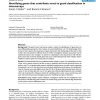Free Online Productivity Tools
i2Speak
i2Symbol
i2OCR
iTex2Img
iWeb2Print
iWeb2Shot
i2Type
iPdf2Split
iPdf2Merge
i2Bopomofo
i2Arabic
i2Style
i2Image
i2PDF
iLatex2Rtf
Sci2ools
BMCBI
2006
2006
Identifying genes that contribute most to good classification in microarrays
Background: The goal of most microarray studies is either the identification of genes that are most differentially expressed or the creation of a good classification rule. The disadvantage of the former is that it ignores the importance of gene interactions; the disadvantage of the latter is that it often does not provide a sufficient focus for further investigation because many genes may be included by chance. Our strategy is to search for classification rules that perform well with few genes and, if they are found, identify genes that occur relatively frequently under multiple random validation (random splits into training and test samples). Results: We analyzed data from four published studies related to cancer. For classification we used a filter with a nearest centroid rule that is easy to implement and has been previously shown to perform well. To comprehensively measure classification performance we used receiver operating characteristic curves. In the three data sets with good...
| Added | 10 Dec 2010 |
| Updated | 10 Dec 2010 |
| Type | Journal |
| Year | 2006 |
| Where | BMCBI |
| Authors | Stuart G. Baker, Barnett S. Kramer |
Comments (0)

